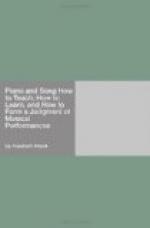And now allow me, Miss Emily, since you are pretty well advanced, and are not quite spoiled, to show you in a few lessons how to study these variations by Herz (Les Trois Graces, No. 1, on a theme from “The Pirates"). They are not easy; but I will teach them in a way that shall not weary you or give you a distaste for them. I have intentionally chosen these variations, because they do not lay claim to great musical interest; and, consequently, their mode of performance, their execution, gives them their chief value. Moreover, they possess the disadvantage for teaching that they are of unequal difficulty, and require, therefore, the more skill on the part of the teacher to compensate for this.
First Lesson. Miss Emily, these are very clear, graceful variations, which require an extremely nice, delicate execution; and, especially, a complete mechanical mastery of their various difficulties. Although these variations may seem to you too easy, I am governed in the selection of them by the maxim that “what one would learn to play finely must be below the mechanical powers of the pupil.” The theme of the Italian song, which is the basis of these variations, is very well chosen, and you must take great pains to execute it as finely as possible, and to produce a singing effect upon the piano-forte. After the piece is thoroughly learned, you will be greatly aided in the production of this imitation of singing by the careful and correct use of the pedal which raises the dampers. The theme does not offer great mechanical difficulties; but it requires a loose, broad, full, and yet tender touch, a good portamento, and a clear and delicately shaded delivery; for you must remember that “in the performance of a simple theme the well-taught pupil may be recognized.”
EMILY. But you do not begin at the beginning: there is an introduction to the piece.
DOMINIE. Perhaps we shall take that at the last: I can’t tell yet when. A great many things in my instruction will seem to you misplaced: it may be that the final result will restore to me the approval which I desire.
EMILY. Do you always give such a preliminary description before you begin a piece with a pupil?
DOMINIE. I like to do so; for I wish to create an interest in the piece, and to state in connection my principles and views about music and piano-playing. Now we will try the theme, first quite slowly; and then the first easy variation, with the last bars at the end of it, which introduce the theme once more, and which should be played very clearly and smoothly. We will then take from the introduction only the right hand, and study the most appropriate fingering for it. I never write this out fully; but only intimate it here and there, in order not to interfere with the spontaneous activity of the learner. We will also take a few portions for the left hand from the finale. In these you must carefully observe the directions which are given for its performance, and try to execute every thing correctly and clearly; for a careless bass is prejudicial to the very best playing in the treble.




